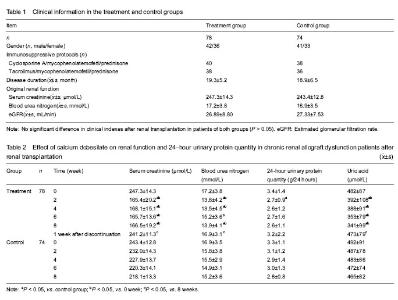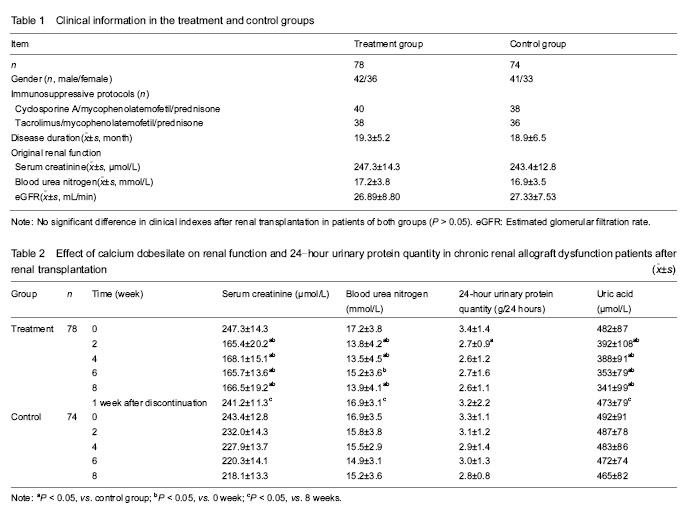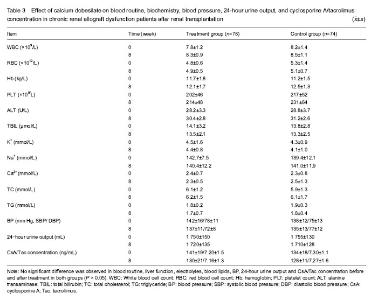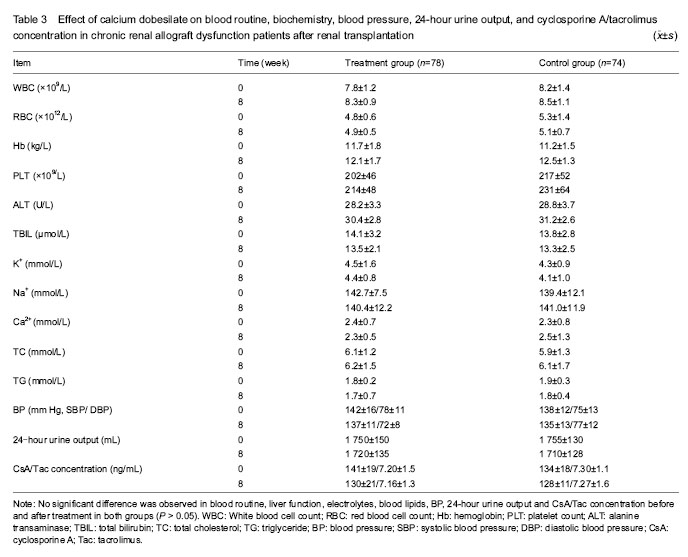Chinese Journal of Tissue Engineering Research ›› 2014, Vol. 18 ›› Issue (49): 7979-7984.doi: 10.3969/j.issn.2095-4344.2014.49.019
Previous Articles Next Articles
Clinical observation of calcium dobesilate in the treatment of chronic renal allograft dysfunction
Zheng Xue-yang, Han Shu, Zhou Mei-sheng, Fu Shang-xi, Wang Li-ming
- Military Institute of Organ Transplantation, Changzheng Hospital, Second Military Medical University of Chinese PLA, Shanghai 200003, China
-
Revised:2014-09-08Online:2014-11-30Published:2014-11-30 -
Contact:Han Shu, M.D., Ph.D., Associate professor, Associate chief physician, Master’s supervisor, Military Institute of Organ Transplantation, Changzheng Hospital, Second Military Medical University of Chinese PLA, Shanghai 200003, China -
About author:Zheng Xue-yang, Master, Physician, Military Institute of Organ Transplantation, Changzheng Hospital, Second Military Medical University of Chinese PLA, Shanghai 200003, China
CLC Number:
Cite this article
Zheng Xue-yang, Han Shu, Zhou Mei-sheng, Fu Shang-xi, Wang Li-ming. Clinical observation of calcium dobesilate in the treatment of chronic renal allograft dysfunction[J]. Chinese Journal of Tissue Engineering Research, 2014, 18(49): 7979-7984.
share this article

Quantitative analysis and clinical information of subjects A total of 152 chronic renal allograft dysfunction patients entered the final analysis. The general information and baseline data were shown in Table 1. There were no significant differences in demographic, disease duration, original renal function, and immunosuppressant administration between the two groups prior to treatment (P > 0.05). Effect of calcium dobesilate on renal function For patients receiving calcium dobesilate, serum creatinine, blood urea nitrogen and uric acid decreased obviously at the time of two weeks after treatment and maintained at a stable level (P < 0.05). The 24-hour urinary protein did not change much compared with the control group (P > 0.05; Table 2). However, serum creatinine and blood urea nitrogen in patients receiving calcium dobesilate returned to the original level quickly after discontinuation of the drugs (Table 2). Effect of calcium dobesilate on the other indicators According to blood routine, biochemical and other indicators were detected with the venous blood. No significant difference was observed in blood cell count, liver function, blood lipids and electrolytes between the two groups, or pre- and post-therapy in each group (P > 0.05; Table 3). Salt restriction, combination of antihypertensive drugs made the patients’ blood pressure under control, which had no significant difference in both groups (P > 0.05). The same situation was observed in the 24-hour urine output no matter calcium dobesilate use or not (P > 0.05; Table 3). Administration of calcium dobesilate did not change the general condition of patients with renal insufficiency, nor did it affect blood concentrations of the immunosuppressive agents (P > 0.05; Table 3). Adverse reactions of calcium dobesilate in chronic renal allograft dysfunction patients No adverse reactions were identified in the control group, but were observed in four (5%) of 78 patients in the treatment group, including a patient who had facial hot flush, which relieved spontaneously; three patients whose serum alanine transaminase elevated slightly, but returned to normal after administration of hepatoprotective drugs."

| [1] Meier-Kriesche HU, Schold JD, Kaplan B. Long-term renal allograft survival: have we made significant progress or is it time to rethink our analytic and therapeutic strategies? Am J Transplant. 2004;4(8):1289-1295.
[2] Kaplan B. Overcoming barriers to long-term graft survival. Am J Kidney Dis. 2006;47(4 Suppl 2):S52-64.
[3] Schweitzer EJ, Matas AJ, Gillingham KJ, et al. Causes of renal allograft loss. Progress in the 1980s, challenges for the 1990s. Ann Surg. 1991;214(6):679-688.
[4] Chapman JR, O'Connell PJ, Nankivell BJ. Chronic renal allograft dysfunction. J Am Soc Nephrol. 2005;16(10):3015- 3026.
[5] Arceo A, Berber A, Trevi?o C. Clinical evaluation of the efficacy and safety of calcium dobesilate in patients with chronic venous insufficiency of the lower limbs. Angiology. 2002;53(5):539-544.
[6] Michal M, Gotti C. Effect of calcium dobesilate on platelet function. Thromb Res. 1988;51(6):593-605.
[7] Fernández IS, Cuevas P, Angulo J, et al. Gentisic acid, a compound associated with plant defense and a metabolite of aspirin, heads a new class of in vivo fibroblast growth factor inhibitors. J Biol Chem. 2010;285(15):11714-11729.
[8] Ribeiro ML, Seres AI, Carneiro AM, et al. Effect of calcium dobesilate on progression of early diabetic retinopathy: a randomised double-blind study. Graefes Arch Clin Exp Ophthalmol. 2006;244(12):1591-1600.
[9] Einarsdóttir AB, Stefánsson E. Prevention of diabetic retinopathy. Lancet. 2009;373(9672):1316-1318.
[10] Agus GB. Medical treatment of chronic venous disease: evolution or involution? Minerva Cardioangiol. 2011;59(3): 285-298.
[11] Scolari MP, Cappuccilli ML, Lanci N, et al. Predictive factors in chronic allograft nephropathy. Transplant Proc. 2005;37(6): 2482-2484.
[12] Hong LQ, Huang ZY, Luo Y, et al. The outcomes in renal allograft recipients after conversion from cyclosporine A to sirolimus for chronic renal allograft dysfunction. Zhonghua Qiguan Yizhi Zazhi. 2009;30(3):167-171.
[13] Ramanathan V, Suki WN, Rosen D, et al. Chronic allograft nephropathy and nephrotic range proteinuria. Clin Transplant. 2005;19(3):413-417.
[14] Zhang X. Therapeutic effects of calcium dobesilate on diabetic nephropathy mediated through reduction of expression of PAI-1. Exp Ther Med. 2013;5(1):295-299.
[15] Gao MJ, Liu M, Li B, et al. Protective effect of calcium dobesilate against early diabetic nephropathy of rat kidney. Yao Xue Xue Bao. 2009;44(2):126-133.
[16] Beyer J, Meissner KO, Happ J, et al. Effect of calcium dobesilate on permeation of plasma proteins in diabetic patients. Dtsch Med Wochenschr. 1980;105(46):1604-1608.
[17] Anderson S, Diamond JR, Karnovsky MJ, et al. Mechanisms underlying transition from acute glomerular injury to late glomerular sclerosis in a rat model of nephrotic syndrome. J Clin Invest. 1988;82(5):1757-1768.
[18] Takahashi T, Huynh-Do U, Daniel TO. Renal microvascular assembly and repair: power and promise of molecular definition. Kidney Int. 1998;53(4):826-835.
[19] Nankivell BJ, Borrows RJ, Fung CL, et al. Evolution and pathophysiology of renal-transplant glomerulosclerosis. Transplantation. 2004;78(3):461-468.
[20] Berthet P, Farine JC, Barras JP. Calcium dobesilate: pharmacological profile related to its use in diabetic retinopathy. Int J Clin Pract. 1999;53(8):631-636.
[21] Tejerina T, Ruiz E. Calcium dobesilate: pharmacology and future approaches. Gen Pharmacol. 1998;31(3):357-360.
[22] Purkerson ML, Joist JH, Yates J, et al. Inhibition of thromboxane synthesis ameliorates the progressive kidney disease of rats with subtotal renal ablation. Proc Natl Acad Sci U S A. 1985;82(1):193-197.
[23] Schmidt M, Michal M. Inhibition of sorbitol formation in human erythrocytes by calcium dobesilate. Arzneimittelforschung. 1989;39(4):493-495.
[24] Schmut O. Effect of calcium dobesilate on the inhibition of collagen fibrillogenesis by glucose in vitro. Arzneimittelforschung. 1989;39(12):1555-1557.
[25] Suschek C, Kolb H, Kolb-Bachofen V. Dobesilate enhances endothelial nitric oxide synthase-activity in macro- and microvascular endothelial cells. Br J Pharmacol. 1997; 122(7): 1502-1508.
[26] Brunet J, Farine JC, Garay RP, et al. Angioprotective action of calcium dobesilate against reactive oxygen species-induced capillary permeability in the rat. Eur J Pharmacol. 1998;358(3): 213-220.
[27] Liu XM, Liu XC. Effects of calcium dobesilate on serum creatinine. Zhongguo Xiandai Yixue Zazhi. 2004;14(24): 70-73.
[28] Yu JR, Pan GH, Ju P. The effect of calcium dobesilate on creatinine measurement by sarcosine oxidase assay. Zhonghua Jianyan Yixue Zazhi. 2013;36(2):161-164. |
| [1] | Li Quanxi, Shen Yu, Wan Wei, Sun Shanzhi. Changes of abdominal wall mechanics and pain after tension-free inguinal hernia repair with polypropylene mesh [J]. Chinese Journal of Tissue Engineering Research, 2021, 25(4): 548-552. |
| [2] | Zhang Liang, Ma Xiaoyan, Wang Jiahong. Regulatory mechanism of Shenshuai Yin on cell apoptosis in the kidney of chronic renal failure rats [J]. Chinese Journal of Tissue Engineering Research, 2021, 25(23): 3672-3677. |
| [3] | Gan Lili, Xiong Na, Liu Yanfei. Hydrogel as drug scaffold in skin wound repair: challenges of clinical application possibilities [J]. Chinese Journal of Tissue Engineering Research, 2021, 25(22): 3578-3583. |
| [4] | Zhi Yibo, Zhang Jie, Liu Jian, Li Weiyan. Chemokine CCL21 in anterior cingulate cortex is involved in chronic neuropathic pain in a rat model [J]. Chinese Journal of Tissue Engineering Research, 2021, 25(2): 242-246. |
| [5] | Li Jie, Xu Jianzhen, Hu Ping, Lei Qiqi, Zhang Wenning, Ao Ningjian . Preparation and performance evaluation of carboxymethyl chitosan/oxidized glucomannan/Panax notoginseng compound sponge dressing for chronic wound [J]. Chinese Journal of Tissue Engineering Research, 2021, 25(16): 2528-2534. |
| [6] | Xiu Yiping, Zhang Liyan, Qian Xueyi, Li Yan, Li Wantong. The clinical application of platelet-rich plasma to repair chronic refractory wounds: a retrospective study and literature retrieval evidence analysis [J]. Chinese Journal of Tissue Engineering Research, 2020, 24(8): 1231-1237. |
| [7] | Ding Meizhu, Hu Peixin, Shen Qian, Zhong Shuxian, Yang Yalan, Li Chun. Remote rehabilitation applied in patients with stable stage of chronic obstructive pulmonary disease: a meta-analysis [J]. Chinese Journal of Tissue Engineering Research, 2020, 24(8): 1306-1312. |
| [8] | Li Siyu, Wang Qingsong. Effect of chronic cerebral hypoperfusion on expression of Occludin and Claudin-2 in rat ileum mucosa [J]. Chinese Journal of Tissue Engineering Research, 2020, 24(32): 5186-5191. |
| [9] | Li Qinwen, Liang Jie, Wang Dongmei, Shang Zhenghui. Fibrotic changes in rat dorsal root ganglion following chronic sciatic nerve compression [J]. Chinese Journal of Tissue Engineering Research, 2020, 24(29): 4686-4691. |
| [10] | Lu Shuqing, Li Xin, Guo Jin, Liu Shiyu, Yang Shunbo, Feng Yuxia, Pang Wei. Advantages in instrument-assisted soft tissue mobilization for chronic soft tissue injury [J]. Chinese Journal of Tissue Engineering Research, 2020, 24(29): 4709-4716. |
| [11] | Li Wei, Chu Zhanfei, Yu Zechen, Yu Jinghong, Jia Yanbo, Wang Zongbo. T2-mapping quantitative imaging technique based on sequence optimization in the ankle talus osteochondral injury [J]. Chinese Journal of Tissue Engineering Research, 2020, 24(27): 4333-4337. |
| [12] |
Mou Zichao, Wang Dan, Wang Xiaoyan, Li Siyu, Wang Zhiqiang, Wang Qingsong.
Oral simvastatin for 3 continuous months improves learning and memory ability of chronic cerebral hypoperfusion rats [J]. Chinese Journal of Tissue Engineering Research, 2020, 24(26): 4190-4195. |
| [13] |
Gu Yingxuan, Huang Linfeng, Hu Xiaohui, Quan Xiaoming, Kang Liangqi, Zhou Linghan, Wang Xiaojun.
Platelet-rich plasma combined with negative pressure for chronic refractory wounds: a meta-analysis [J]. Chinese Journal of Tissue Engineering Research, 2020, 24(26): 4257-4264. |
| [14] | Wu Hui, Xu Nuo, Wang Qian, Shi Chun, Jiang Long. Screening chronic periodontitis-related genes using whole-genome expression profiling [J]. Chinese Journal of Tissue Engineering Research, 2020, 24(23): 3615-3620. |
| [15] | Liang Long, Yu Jie, Wei Xu, Zhou Shuaiqi, Yin Xunlu, Liu Guangwei, Xie Rui, Xie Rong, Zhuang Minghui, Zhu Liguo, Feng Minshan. Establishment and evaluation of a cadaveric model of chronic strain-induced upper cervical spine instability based on fascia-bone theory [J]. Chinese Journal of Tissue Engineering Research, 2020, 24(20): 3152-3156. |
| Viewed | ||||||
|
Full text |
|
|||||
|
Abstract |
|
|||||

